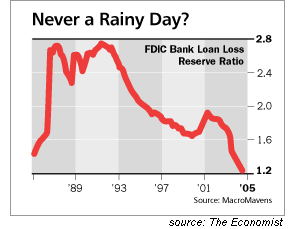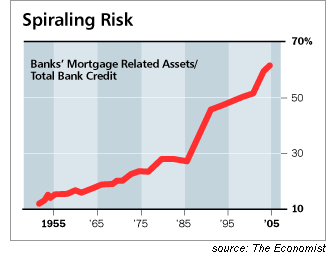

|
| weblog/wEssays archives | home | |
|
Mortgage Lenders on the Precipice (September 1, 2006) Astute correspondent Paul M. alerted me to a looming risk buried in the easy-money, bubblicious go-go mortgage lending of the past few years--stated-income loans: (emphasis added) 
As a self-employed professional and homeowner, I understand the usefulness of "stated-income" mortgage lending. But I agree that taking the borrower's word for something as fundamental as his ability to repay is a completely inappropriate basis upon which to make a rational lending decision. The secondary mortgage market could be characterized, therefore, as irrational. The question begged, then, is: to what extent?For those of you not familiar with stated-income mortgages, here's how it works. let's say I am an independent contractor or self-employed person without pay stubs from an employer. My actual income is $40,000 a year, but alas, that doesn't qualify me to buy an outhouse in today's market. But fortunately, there are mortgage lenders who don't require any pesky documentation of income, such as tax returns. All I have to do is "state" my income, which I do--as $75,000 a year. Presto, I now qualify for my very own McMansion in exurbia. Isn't modern lending wonderful? But oops, my income has dropped recently, and it's now either make the car payment, pay the fire insurance and cover the minimum on my five credit card payments, or pay the mortgage. Guess I'll "defer" the mortgage because, hey, I think I'll do better next year and then I'll catch up. You see where this is going, don't you? Stated-income loans have been sold and packaged as low-risk mortgages, and promptly tranched into mortgage-backed securities which have been sold off in the hundreds of billions. They are gone, Baby--there is no way investors who bought these securities can pick through hundreds or thousands of mortgages and "return to sender" the ones which are going bad. These securities are in the hands of Swiss re-insurance firms, Thai banks, hedge funds--you name it. They're all over the globe. The risks of many of these mortgages--the stated-income ones, the adjustable-rate (ARM) ones, the interest-only ones, even the obviously subprime ones (see below) have neen grossly misrepresented.  The net result: as the defaults start kicking in, the value of these mortgage-backed securities,
which are basically bonds, plummets
as over-stretched borrowers stop paying their mortgage. As the income stream dries up,
so does the value of the security. Now as I have explained before, many of these securities
have been sliced and diced (tranched) into various levels of risk: some collect only interest,
which is considered higher risk than those which collect only the principle payments. And of
course the securities have supposedly been tranched by the risks posed by the borrower as
well.
The net result: as the defaults start kicking in, the value of these mortgage-backed securities,
which are basically bonds, plummets
as over-stretched borrowers stop paying their mortgage. As the income stream dries up,
so does the value of the security. Now as I have explained before, many of these securities
have been sliced and diced (tranched) into various levels of risk: some collect only interest,
which is considered higher risk than those which collect only the principle payments. And of
course the securities have supposedly been tranched by the risks posed by the borrower as
well.
The point is: have the risks been accurately priced in? Given the low returns, the absurdly low reserves and the obvious risks of the housing bubble deflating, the answer is clearly a resounding "no." So what happens when option ARM mortgage holders stop paying their monthly tab? Both tranches lose out. The "low risk" tranch is just as vulnerable to defaults as the "higher risk" tranch. Which means what? Risk has been completely and totally mismanaged on a vast scale. The entire lending and investment banking industries have been acting as if the housing and mortgage markets are rock-solid, with default rates of under 1%, even as the reality has been a Wild West orgy of risky lending to people with no capital and shaky or over-stated incomes. Correspondent Wayne D. recently alerted me to the importance of the losses announced by H&R Block's mortgage lending subsidiary, and voila, here is an excellent account of the sobering risks facing the mortgage and mortgage-backed securities industries in the Wall Street Journal: Mortgage Market Begins to See Cracks As Subprime-Loan Problems Emerge: Last week, H&R Block, the big tax preparer, alerted Wall Street that its Option One Mortgage unit, which focuses on the subprime market, would have to set aside about $60 million, or 19 cents a share, because borrowers were falling behind on their payments.Correspondent Albert T. had alerted us to something rotten in the state of WAMU's financial reports some weeks ago (Basel II, Risk and Leverage) and here we have confirmation in the Wall Street Journal. Albert had observed that WAMU's loan loss reserves were insanely low--that the lender expected something like 1/10 of one percent of its loans to go bad. Now we discover that fully 70% of its option ARM loan portfolio is at risk. Do you reckon WAMU has set aside enough cash to cover those losses? Not even close, according to their financial statement notes. So what's that mean? Massive defaults in subprime and option ARM loans, creating equally massive (and obviously unexpected) losses to lenders and holders of mortgage-backed securities. In other words, the unraveling of stupendously risky mortgage portfolios which have been supported by unprececentedly feeble reserves for bad debt. Is this endemic mismanagement of risk evidence of a "healthy" mortgage industry and economy? I think not. Thank you, correspondents Paul M, Wayne D. and Albert T. for your insightful alerts on this subject. For more on this subject and a wide array of other topics, please visit my weblog. copyright © 2006 Charles Hugh Smith. All rights reserved in all media. I would be honored if you linked this wEssay to your site, or printed a copy for your own use. |
||
| weblog/wEssays | home |